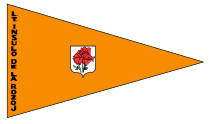Republic of Rose Island
| Republic of Rose Island | |
|---|---|
| Repubblica dell'Isola delle Rose | |
| Unrecognized micronation | |
 | |
 | |
| Claimed by | Giorgio Rosa |
| Dates claimed | 1 May 1968–26 June 1968 (Italian Navy assumed control) or 26 February 1969 (disestablished) |
| Area claimed | 0.0004 square kilometres (0.00015 sq mi) |
| Location | Offshore platform in Adriatic Sea, near Emilia-Romagna, Italy |



The Republic of Rose Island (
However, it was never formally recognized as a sovereign state by any country of the world. The Italian government viewed it as a ploy by Rosa to raise money from tourists while avoiding national taxation. Rose Island was occupied by the Italian police forces on 26 June 1968, subject to naval blockade, and eventually demolished in February 1969.[3][4]
Etymology
It is believed that the Esperanto term Rozoj (in Italian: rose) was borrowed from the surname of Giorgio Rosa, the designer and builder of the artificial platform, as well as the creator and inspirer of the state entity, as well as from his desire to "see roses bloom on the sea".[5]
History
In 1958, Italian engineer Giorgio Rosa funded the construction of a 400-square-metre (4,300 sq ft) platform supported by nine pylons and furnished it with a number of commercial establishments, including a restaurant, bar, nightclub, souvenir shop, and post office, with construction being completed in 1967.[6]
The platform declared independence on 1 May 1968, under the Esperanto name Insulo de la Rozoj, with Rosa as self-declared president. Rose Island issued a number of stamps, including one showing its approximate location in the Adriatic Sea. The purported currency of the republic was the mill, and this appeared on early stamp issues, although no coins or banknotes are known to have been produced.[7]
Rosa's actions were viewed by the Italian government as a ploy to raise money from tourists while avoiding national taxation. Whether or not this was the real reason behind Rosa's micronation, the Italian government's response was swift: On 26 June 1968, 55 days after the island declared independence, the Italian navy sent a group of four carabinieri and Guardia di Finanza officers, who assumed control, cleared the island, and set up a blockade so no one could re-enter.[7][8]
At first, the Italian government tried to dismantle the island, but they found it impossible, so they decided to blow it up instead. The
Rosa died in 2017, having given his blessing for a film to be made about Rose Island. This was released in 2020.[10]
Since the first decade of the 2000s, Rose Island's history has been the subject of documentary research and rediscoveries, based on the utopian aspect of its genesis.[11]
In popular culture
- Rose Island is featured in the Italian comic book Martin Mystère, n. 193.[12]
- Rose Island, a 2020 film based on the story of the micronation, directed by Sydney Sibilia, was released on Netflix on 8 December 2020.[13]
See also
- REM Island, a platform towed into international waters for the purposes of offshore radio broadcasting.
- Republic of Minerva, a short-lived artificial island micronation in the Pacific Ocean.
- Sealand, a declared principality near the United Kingdom, built on a World War II sea fort.
References
- ^ a b Marco Imarisio. "Riemerge l'isola dell'Utopia". Corriere della Sera (in Italian).
- ^ "Piattaforma davanti a Rimini proclamata "Stato indipendente"". La Stampa (in Italian).
- Stampa Sera(in Italian).
- ^ Edda Montemaggi. "Circondato dalle motovedette lo "Stato" al largo di Rimini". La Stampa (in Italian).
- ^ "Isola Delle Rose" (PDF). Archived from the original (PDF) on 20 December 2007.
- ^ Rome, Wanted in (15 December 2020). "Rose Island: a true and incredible Italian story". Wanted in Rome. Retrieved 5 January 2024.
- ^ a b "Stamping a Nations Identity: Rose Island". Stanley Gibbons. 20 January 2021. Retrieved 17 September 2023.
- ^ a b "The man who built Rose Island: 'Creating it was his scream for freedom'". Sky News. Retrieved 5 January 2024.
- ^ "When Italy went to war with the esperanto micro-nation Insulo de la Rozoj",visit-rimini.com, date 9 May 2009
- ^ "Rose Island: Netflix adapts the story of 'prince of anarchists' Giorgio Rosa". BBC News. 7 December 2020.
- ^ Fabio Vaccarezza. Rose Island: A Dream of Freedom. The Cinderella Philatelist. pp. 42–46.
- ^ Scheda di Martin Mystere n 193 L'isola delle Rose
- ^ "Rose Island: Netflix adapts the story of 'prince of anarchists' Giorgio Rosa". BBC. 7 December 2020. Retrieved 9 December 2020.
Further reading
- Vaccarezza, Fabio (January 2007). "Rose Island: A Dream of Freedom". The Cinderella Philatelist: 42–46. ISSN 0009-6911.
- Strauss, Erwin S. (1984). How to Start Your Own Country (2nd ed.). Port Townsend, WA: Breakout Productions. pp. 129–130. ISBN 1-893626-15-6.
- Menefee, Samuel Pyeatt (Fall 1994). "'Republics of the Reefs': Nation-Building on the Continental Shelf and in the World's Oceans". California Western International Law Journal. 25 (1): 105–06. ISSN 0886-3210.
External links
- Italian-language website - discusses the history of Rose Island and its postage stamps. Includes a scan of part of a contemporary newspaper article.[dead link]
- Bijoux, Thérèse (24 January 2007). "L'Insulo de Rozoj...storia di una fiaba di costume fine anni 60" (in Italian). Archived from the original on 19 April 2014.(including pictures of its destruction) and comments from the daughter of one of the people responsible for the destruction (Italian language)
